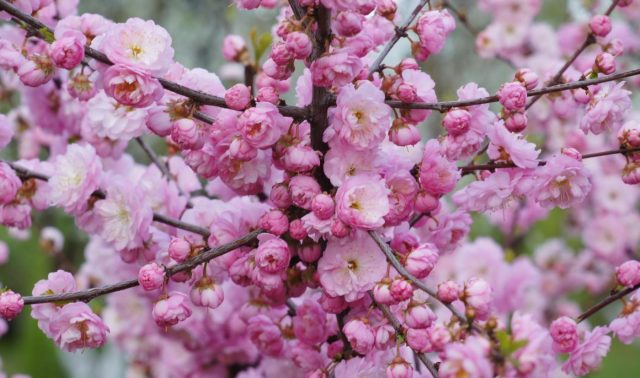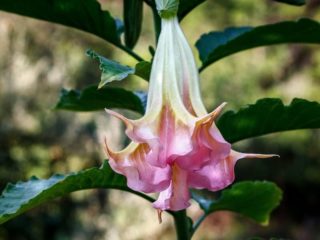Content
This amazing plant has two names at once. Or more precisely, three. It was also known as Chinese double plum. Residents of Western Europe call the shrub double plum, and in the Soviet Union it took root as the three-lobed almond. The common people called it sakura, although this plant has nothing to do with the Japanese cherry. The unusually beautiful flowering bushes immediately won the hearts of gardeners and collectors. But you won’t find Louiseania in parks. Her color is too gorgeous. Decorative branches are broken off for bouquets. And the secrets of growing this plant are not known to all landscapers. But you can still grow a mysterious Asian woman on your own plot. It’s not difficult to understand the variety of types and subtleties of caring for three-lobed almonds.
Description of three-lobed almonds
This plant is a small tree or shrub 2-3 m high. Its bark is brownish. The leaf blades are three-lobed with small teeth; on the reverse side they have a slightly grayish tint. The flowers are double, about 2.5 cm in size, and can be white or pink.After flowering, in many species, fruits appear - a small drupe, slightly round in shape.
Popular varieties
Three-lobed almonds, photos of which are presented below, have many types.
The most popular of them:
- Captivity. One of the most famous varieties of three-lobed almonds. It has double flowers (up to 4 cm in diameter). Interestingly, the flowering period of the plant coincides with the appearance of leaves on the branches. As a result, the bush becomes lush and branched (reaches a height of 2 m). Immediately after flowering, all the fruits fall off before they have time to ripen and produce seeds.
- Kyiv. The plant is tall (about 3.5 m). The color of the flowers is darker and more saturated. It is characterized by earlier and more abundant flowering, but it lasts no more than a week. Then the leaves bloom. Has a rich almond aroma.
- Stonefly. An excellent standard variety. The flowers are a little flat, but retain their doubleness. They are distinguished by delicate shades of pink, but turn white before withering. Gardeners prefer this variety for its hardiness and resistance to diseases (even to monolithic burn).
- Rosenmund. European variety, awarded with international awards. Almond three-lobed Rosenmund has bushes of compact size with large flowers (5 cm in diameter). The budding period is longer than the others - up to 21 days.
- Crimson. The plant is characterized by the presence of straight shoots. They are strewn with flowers of a deep crimson hue. The plant does not bear fruit.
- Chinese. Famous hybrid. The branches of the plant bush are erect, it blooms early and is not brightly colored. Breeding method: grafting onto felt cherry. Outwardly, it is very reminiscent of sakura.The three-lobed Chinese almond bears fruit for years, resembling felt cherries in appearance, only much larger.
- Tanyusha. The shrub is relatively small, but very beautiful. The flowers of the plant are bright, with a large double corolla, which in turn consists of three dozen intricately curved petals.
Planting and caring for three-lobed almonds
Overall, this plant is not difficult to grow. Beginners may encounter some difficulties. But, having sufficient information about the preferences of the three-lobed almond, you can safely plant it in your garden. Rare shrubs can compare with it in terms of decorativeness.
Preparation of planting site and material
First, you should select a healthy and viable three-lobed almond seedling. They can often be purchased in special containers. Three-year-old specimens are suitable as planting material. Their root system is already quite strong.
The site should be sunny, but without drafts and gusty winds (especially in the cold season). Places flooded by spring floods are also prohibited. Triloba almond responds calmly to some shading. And there are no special requirements for the composition of the soil.
Garden soil for three-lobed almonds must be fed with humus (add two parts), and sand must be used as a leavening agent (no more than one part).
Landing rules
Three-lobed almonds have good pollination. Therefore, gardeners often plant several specimens at a time.It is necessary to dig holes 30-40 cm deep (maximum half a meter). A distance of at least 3 m is made between them. The bottom is laid with a 10-15 cm layer of good drainage. You can use crushed stone. Sprinkle sand on top, then place the plant and cover it with earth.
Immediately after planting, the bush is watered abundantly, tied to a support, and the ground around is mulched.
Watering and fertilizing
Planted three-lobed almond bushes do not suffer much from moderate drought. But periodically you need to moisten the soil well, especially after planting. The amount of moisture depends on specific climatic conditions and the individual characteristics of the plant. Three-lobed almond seedlings with their own root system do not tolerate stagnant water; it is better to dry them out a little than to flood them.
If rains in the region are frequent enough, then three-lobed almonds will not need additional watering at all. In Louiseanias that have been grafted onto other plants (for example, cherry plum, sloe or plum), they try to keep the trunk circle moist until the second half of July. But here it is also important not to overdo it. The line between wet and wet soil is quite thin. Moisture is introduced exclusively at the root; it is extremely undesirable to get it onto the crown. For good growth and generous flowering of three-lobed almonds, it is necessary to pour at least 2-3 buckets of water under one bush every 3-4 days in the spring.
Louiseania spends most of its energy on flowering. Fertilizers are applied before and after it. At the beginning of spring, they fertilize with organic matter on the melted snow. Use mullein diluted in a concentration of 1:10.It is also useful to use humus (from 5 to 6 kg per plant). After pruning, it is recommended to fertilize three-lobed almonds with urea or ammonium nitrate (10 g/30 l). For August, the best fertilizers are superphosphate (per 1 m2 soil no more than 20 g) and wood ash (a glass of raw materials is diluted with a bucket of water).
Trimming
Caring for three-lobed almonds involves regular pruning. It performs sanitary and formative functions. Held annually. In plants that bear fruit, not all branches are pruned and some of the fruit is retained. For sterile varieties of three-lobed almonds, radical pruning is practiced as soon as they finish flowering. On each shoot there must be a part with 2-3 buds. Young shoots sprout from their axils at the end of the season. Five-year-old branches are removed completely. After winter, sanitary pruning of three-lobed almonds is carried out. It is necessary to get rid of all dead branches.
Preparing for winter
It must be started in advance, in the summer. To speed up the lignification of three-lobed almond shoots, they resort to tweezing, that is, pinching the tops. This way they will be protected from freezing.
Young three-lobed almond bushes are mulched with earth (to a height of 15 cm from the soil level), as well as with materials such as dry leaves, straw or dense lutrasil. It is important to ensure that the root collar does not sour or rot under the snow.
As for standard specimens of three-lobed almonds, their branches must be carefully collected into a bunch, wrapped in non-woven material and tied with ropes.
Reproduction
The following plant propagation options are available:
- By layering. This method of propagating three-lobed almonds is held in high esteem by gardeners.It is quite simple and effective. Low and long branches are ideal. Grooves are made near the bush, three-lobed almond branches are placed in them and fixed. Then they are covered with soil and watered thoroughly. Within a year, the seedling is transferred to a permanent place.
- Cuttings. The source for such planting material is the upper branches of three-lobed almonds. The optimal length of cuttings is from 15 to 20 cm. For successful rooting, they are soaked for 24 hours in a special solution for root formation or growth stimulants are used. Until the cuttings take root, they require constant attention. Afterwards, the three-lobed almonds can be safely planted in the garden.
- Vaccinations. First, you need to grow or select from existing bushes or three-lobed almond trees for grafting (these are so-called rootstocks). It is preferable to work with frost-resistant species. Next, the cuttings themselves are prepared (these are scions). The best period for grafting three-lobed almonds is spring or summer. At this time, the plants produce the most juice. The technology is as follows: an incision is made in the rootstock (above the root collar) and a cutting is inserted into it. For reliable fixation, it is wrapped with tape or tape. When the three-lobed almond takes root, the tapes are peeled off.
- Bones. The most troublesome way. It is used extremely rarely for propagation of three-lobed almonds, since not all varieties are capable of bearing fruit. And if there are fruits, then the process takes too much time and effort. First, the seeds from fresh three-lobed almonds are stratified for a long time. In spring or autumn, you can start planting directly into the ground.Three-lobed almond seeds are placed in 10-centimeter grooves (every 10 cm). Plantings require constant care. All branches of a half-meter seedling are cut off (at a distance of 10 cm from the ground) and then planted around the site. In the future, they will become material for grafting. It is not worth growing to a mature bush, since in most cases such a plant will lose all its maternal characteristics.
Diseases and pests
Three-lobed almond varieties are resistant to common diseases.
But some errors in care can lead to problems:
- Moniliosis. A type of fungal infection that infects Rosenmund almonds through the flowers. Once inside the branches, the spores begin to develop rapidly, which leads to the destruction of the wood. The shoots gradually turn black and resemble charred wood. To avoid infection, opened three-lobed almond flowers must be treated with common antifungal drugs. If the moment has been missed, you will have to cut off all unhealthy-looking shoots.
- milky shine. Another disease of triloba almond caused by bacteria. Typical for the south. Regular inspection of the bush and timely pruning will help prevent it.
- Gray rot. Appears if the summer is cold and damp. May be a result of overwatering or too dense planting. The affected three-lobed almond branches are immediately removed.
Pests rarely attack three-lobed almonds. There are cases of damage by aphids, leaf rollers and plum bark beetles. But they are not systematic. Caring for three-lobed almonds, just like other shrubs, does not create any special difficulties. Sometimes tits can bother you.But just start feeding them, and they will stop feasting on the buds.
Conclusion
The three-lobed almond, or Louiseania, is a plant of rare beauty. For many gardeners, it became mutual love at first sight. All your efforts will be more than repaid when a cloud of fragrant flowers blooms.



















